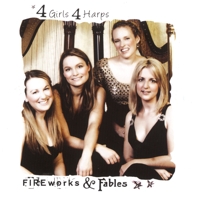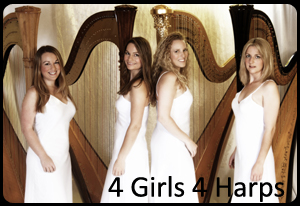Fireworks
& Fables
Buy this album now CD: £12.00 + p&p |
| 1 | Harriet Adie | Sun, Moon and Stars - A Middle Eastern Sky | 6.51 |
| 2 | Ernesco Lecuona Tr. Arabella Spamon |
Malagueña | 4.24 |
| Camille Saint-Saëns | Le Carnaval des Animaux | ||
| 3 | Volière | 1.27 |
|
| 4 | L'Éléphant | 2.01 |
|
| 5 | Aquarium | 2.01 |
|
| 6 | Le Cygne tr. Kajetan Attl | 2.56 |
|
| Maurice Ravel | Ma Mère L'Oye | ||
| 7 | Pavane de la Belle aubois dormant | 1.50 | |
| 8 | Laideronette, Impératrice des Pagodes | 3.46 |
|
| 9 | Les entretiens de la Belle et de la Bête | 4.20 |
|
| 10 | Eleanor Turner | Rambla! | 7.17 |
| G.F. Handel | The Royal Fireworks Music & The Water Music | ||
| 11 | La Réjouissance | 3.15 | |
| 12 | Hornpipe | 1.27 |
|
| 13 | Alla Hornpipe | 3.07 |
|
| 14 | Edward Longstaff | Saraswati | 14.14 |
| 15 | George Gershwin | Summertime | 3.19 |
TOTAL DISC TIME |
62.24 |
||
Sleeve Notes Sun, Moon and Stars Le Carnaval des Animaux by Camille Saint-Saëns
(1835-1921). Ma Mère
L’Oye by Maurice Ravel (1875-1937) Pavane de Ia Belle au bois dormant, Petit Poucet, Laideronnette, Impératrice des Pagodes, Les entretiens de la Belle et de la Bête and Le jardin féerique. In 1911 Ravel wrote an orchestral version of the suite, and this became the basis of the ballet which was first performed in January 1912. For this Ravel wrote some additional pieces (a Prélude and Danse du rouet et scène) as well as some connecting interludes. Ravel wrote that “the idea of evoking in these pieces the poetry of childhood naturally led me to simplify my style and to refine my means of expression”. This can clearly be heard in the Suite through the peaceful, uncomplicated nature of the Pavane de la Belle au bois dormant (reflected in Harriet’s arrangement through the pure sound of the harp’s harmonics) and in the delicate melody representing ‘Belle’ in Les entretiens de la Belle et de la Bête. In Laideronnette, lmpératrice des Pagodes, Ravel evokes the Oriental setting of this story with the use of the pentatonic scale heard throughout the movement and (in his orchestral version) the inclusion of tuned percussion. This flavour is further enhanced in Harriet’s arrangement by using the bass strings of the harp as a ‘gong’! Rambla! (2007) by Eleanor Turner (b. 1982) La Rejouissance and Two Hornpipes by G.F. Handel (1685-1759) arr E.
Turner Saraswati (2002) by Edward Longstaff (b. 1965) Summertime from ‘Porgy
and Bess’ by George Gershwin (1898— 1937)
|
Credits Producer and Engineer: David Hinitt ©2009 Arts in Fusion |
| Title: | Fireworks & Fables |
| Artists: | 4 Girls 4 Harps |
| Instruments: | Harp Quartet |
| Genre: | Classical |
| Format: | CD |
| Our Ref: | A0334 |
| MCPS: | AIF 06 |
| Label: | Arts in Fusion |
| Year: | 2009 |
| Origin: | UK |
Performing on their full-sized Salvi concert harps and modern pearlescent electric harps, Keziah Thomas, Angharad Wyn Jones, Harriet Adie and Eleanor Turner present entertaining programmes of music encompassing many contrasting genres to delight audiences of all ages. With music ranging from Handel, Schubert and Debussy to Gershwin,
Joplin and Lecuona, the dynamic and virtuosic playing of 4 Girls
4 Harps, and the amazing sound of four harps, is guaranteed to
make an impact.
|
|
| Contact Details | 4 Girls 4 Harps |
| info@4girls4harps.com | |
| Blog | 4girls4harps.blogspot.com |
Artists
Web Site |
www.4girls4harps.com |
| Alternatively, for further information about 4 Girls 4 Harps, or if you would like to enquire about availability, please contact | |
| Maureen Phillips |
Upbeat Classical Management PO Box 479 Uxbridge UB8 2ZH |
| Telephone | 01895 259441 |
| enquiry@upbeatclassical.co.uk | |
 Since forming in 2000, under the guidance
of Daphne Boden at the Royal College of Music in London, 4 Girls
4 Harps have gone from strength to strength, creating and commissioning
new music for harp quartet. Whilst each member of the group enjoys
a varied career in their own right, the girls agree that rehearsing
and performing as a unit is a real meeting of minds. Fireworks
and Fables takes you on a journey across the globe, visiting countries
as far afield as India, Spain and the Middle East. Enjoy the music!
Since forming in 2000, under the guidance
of Daphne Boden at the Royal College of Music in London, 4 Girls
4 Harps have gone from strength to strength, creating and commissioning
new music for harp quartet. Whilst each member of the group enjoys
a varied career in their own right, the girls agree that rehearsing
and performing as a unit is a real meeting of minds. Fireworks
and Fables takes you on a journey across the globe, visiting countries
as far afield as India, Spain and the Middle East. Enjoy the music! 





